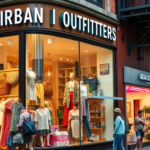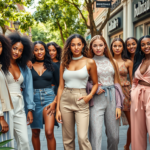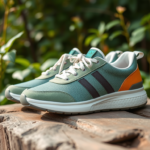
In the wake of unprecedented global events and the rise of digital technologies, the fashion industry stands at the cusp of a radical transformation. As we adapt to the new norm of living, fashion brands and designers are grappling with changing consumer behaviors, sustainability concerns, and the need for technological integration. The future of fashion is poised for a revolution, characterized by innovative materials, circular business models, digital fashion experiences, and a stronger focus on inclusivity.
Embracing Sustainability
The urgency of addressing the environmental impact of fashion cannot be overstated. In the coming years, the industry is set to witness an uptick in sustainable practices. This includes not only sustainable sourcing of materials but also improving the environmental footprint along the entire supply chain. Brands are expected to pivot towards:
- Using eco-friendly fabrics such as organic cotton, hemp, or recycled polyester.
- Implementing water-saving dyeing techniques and energy-efficient manufacturing.
- Developing take-back and recycling programs to reduce fashion waste.
- Adopting circular fashion models to enhance product longevity and reuse.
Moreover, transparency about the production process and the sustainability of garments will become paramount, as consumers increasingly demand to know the origins and environmental cost of their clothing.
Tech Integration and Digital Transformation
The integration of technology is reshaping the fashion industry at an exponential rate. Artificial Intelligence (AI) and Virtual Reality (VR) are becoming integral parts of the design, manufacturing, and retail processes. We can anticipate several developments in this space:
- AI-driven trend forecasting and inventory management will dramatically reduce waste and unsold stock.
- VR and Augmented Reality (AR) will enhance online shopping experiences with virtual fitting rooms and personalized avatars.
- Blockchain technology will provide unparalleled transparency and traceability for fashion items.
- 3D printing will promote on-demand manufacturing, reducing the need for mass production.
These technological advancements will not only cater to the demand for personalized experiences but also enable brands to operate more efficiently and sustainably.
The Rise of Slow Fashion
Amidst a growing awareness of the pitfalls of fast fashion, the industry is shifting towards a slower, more thoughtful approach to consumption. Slow fashion emphasizes quality over quantity, heritage craftsmanship, and timeless design. Key aspects of this movement include:
- Seasonless collections that reject the traditional fashion calendar.
- Small-batch production runs that focus on demand to mitigate excess inventory.
- Consumers investing in durable, well-crafted pieces with longer wearability.
- Storytelling that highlights artisan skills and the cultural significance of garments.
This approach not only minimizes the environmental impact but also celebrates the artistry and tradition of fashion, creating a deeper connection between consumers and their clothing.

Advancing Diversity and Inclusion
As global conversations around inclusivity intensify, the fashion industry is recognizing the importance of representation and diversity. Brands are now tasked with not only showcasing a diverse range of models but also meeting the needs of an increasingly diverse consumer base. This involves:
- Expanding size ranges to cater to all body types.
- Designing adaptive clothing for people with disabilities
- Celebrating diversity through campaigns and brand stories.
- Ensuring diversity within company leadership and creative teams.
Through these steps, the fashion industry can foster a sense of belonging and empowerment for consumers from all walks of life.
Direct-to-Consumer and Customization
The direct-to-consumer (D2C) model is rapidly gaining ground, offering brands a way to establish a direct relationship with their consumers. Alongside D2C, customization and personalization are becoming increasingly attractive to consumers who desire unique items that reflect their individual style. We can expect:
- More brands to bypass traditional retail channels and sell directly through their websites or branded stores.
- Growth in the use of online platforms that allow consumers to customize products to their preferences.
- Investment in technologies enabling consumers to co-create products with designers.
- Expansion of made-to-measure services that ensure a perfect fit for consumers.
As a result, the bond between brand and consumer will strengthen, leading to increased brand loyalty and consumer satisfaction.
Conclusion
The future of the fashion industry is an exciting fusion of tradition and innovation. As we look ahead, it is clear that sustainability, technology, slow fashion, inclusivity, and direct engagement with consumers will be the driving forces shaping the landscape. The industry’s readiness to adapt and evolve will not only redefine the way we view fashion but also how we participate in it as conscious consumers. The next chapter for fashion is one of meaningful engagement — with the environment, society, and individual identities.
FAQs
1. How will sustainability affect fashion design? Sustainability in fashion design will focus on eco-friendly materials, waste reduction in production, and designing for longevity rather than disposability. Designers will increasingly use organic, recycled, and biodegradable fabrics and adopt zero-waste cutting techniques.
2. What role will technology play in the future of fashion retail? Technology will greatly enhance the retail experience through AI for personalized recommendations, AR for virtual try-ons, and improved online shopping interfaces. It will also help in inventory management and provide consumers with more information about their purchases.
3. What is slow fashion, and why is it important? Slow fashion is an approach that emphasizes quality over quantity, mindful consumption, and the longevity of garments. It is important because it combats the throwaway culture of fast fashion and promotes a more sustainable and ethical fashion industry.
4. How is the fashion industry addressing the need for increased diversity and inclusion? The fashion industry is expanding size ranges, creating adaptive clothing, showcasing diverse models, and addressing internal company diversity to create a more inclusive environment for all consumers.
5. What benefits do direct-to-consumer and customization offer? Direct-to-consumer models and customization offer consumers products that are more aligned with their personal style and needs, often leading to higher satisfaction. They also foster closer relationships between brands and consumers, enhancing loyalty and brand advocacy.




